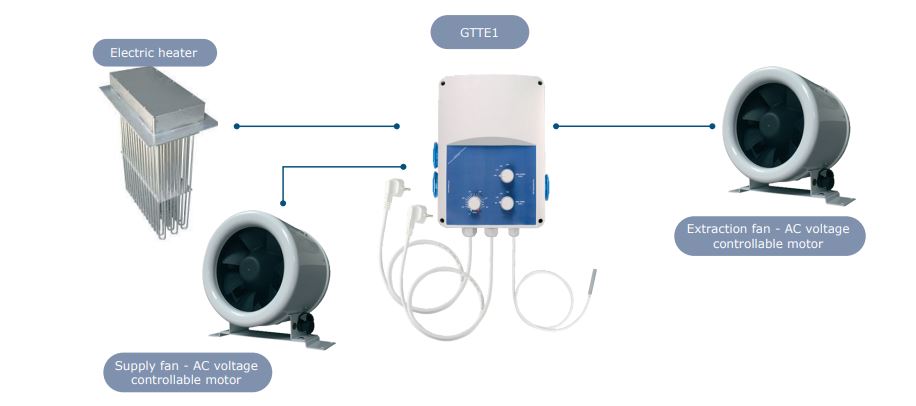EU declaration conformity
Fan controller | heater controller | Grow room controller | 3,5 A
Product description
This fan speed controller has five settings and is prewired. The Euro sockets can connect two AC fans with single-phase motors and an electric heating element. The maximum combined motor current is 3,5 A, and the maximum current for the electric heater is 16 A.
When the ambient temperature falls below the predetermined temperature, the fan(s) slow down and the heater kicks on. When the ambient temperature rises over the predetermined temperature, the electric heater is turned off and the fan speed gradually increases.
The standard wired PT500 probe is used to measure the ambient temperature. The potentiometer on the front panel can be used to modify the setpoint temperature. The two rotary switches control the high and low fan speeds.
The power supply voltage is 230 VAC.
Documents
Additional specifications and description
Transformer-based fan speed controllers offer a range of benefits, making them a desirable choice for speed control solutions. These controllers are known for their robustness, user-friendly nature, efficiency, and affordability. One significant advantage of using transformer-based control units is their ability to provide speed control without relying on electromagnetic excitation in motors. This feature makes them particularly suitable for environments where noise sensitivity is a concern. What you get by a transformer fan speed controller is: silent motor operation, simple control in steps and a controller with a long service life at a reasonable price!
The GTTE1 series is a 5-step fan speed controller with temperature-based fan speed control and electric heater control. This fan speed controller offers a convenient and customizable solution for temperature-based fan speed control and electric heater management in a robust and user-friendly package.
Fan speed control
The controller has two Schuko Euro sockets to connect AC fans – a supply and an extraction fan. It can control the speed of these fans in five steps. The minimum and maximum fan speed as well as the temperature setpoint are set via the built-in knobs on the enclosure. When the ambient temperature is below the set temperature, the fan(s) run at the minimum speed.
Temperature sensing
The ambient temperature is monitored using a passive temperature probe (PT500) that is connected to the controller. This probe has a cable length of 4 meters to ease placing the sensor element in the appropriate place.
Stepwise fan speed adjustment
As the ambient temperature exceeds the setpoint temperature, the fan speed increases in steps. This means that the controller can automatically adjust the fan speed based on the temperature, ensuring optimal ventilation and cooling.
Electric heater control
The controller also has a third Schuko socket that can be used to connect an electric heater. When the ambient temperature drops below the set temperature, the electric heater is activated to provide heating. Conversely, when the ambient temperature is higher than the set temperature, the heater is deactivated, helping to maintain a comfortable temperature.
Plug-and-play installation
This fan speed controller is designed for easy installation and does not require any wiring. It comes with two separate supply cables with Europlugs (cable length 1.5 meters), allowing you to power the fan and electric heater via different circuits. The three separate Schuko Euro sockets provide flexibility for connecting the supply fan, extraction fan, and electric heater.

Installation requirements
Make sure that the fan speed controller can cool sufficiently. Preferably install it in a cool place, best not in direct sunlight.
Durable enclosure
The housing of this fan speed controller is designed and manufactured in-house using high-quality r-ABS VO (UL94) plastic, which possesses several desirable properties for this application. The flame-extinguishing nature of r-ABS VO plastic ensures an added level of safety, which is crucial in industrial environments where fire hazards may be present. Its toughness and impact resistance make it well-suited for protecting the internal components of the controller from accidental damage or rough handling.
The IP54 protection rating provided by the enclosure offers a good level of defense against both dust and water ingress. This protection is particularly important in industrial settings where airborne particles and moisture can pose risks to electronic devices. With this level of protection, the fan speed controller can operate reliably even in environments where dust and water exposure may occur.


Remarks, reviews & ratings